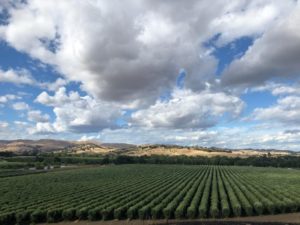Growing Together Spring 2023
Growing a Taste of the Mediterranean: Olives represent crop diversification opportunity for Sacramento Valley growers
Diversifying in agriculture is often accelerated by a myriad of variables. Sometimes it’s to meet growing market demand. In other cases, it’s to capitalize on land or resources ill-suited for other operations.
Olives for oil production in the Sacramento Valley check both boxes. In the decade since high-density olive groves began moving into the area, the crop has shown promise for growers with the right land, equipment, infrastructure and market opportunity. Diversifying into olive production is today a real possibility for growers in the right situations.
“There was a push here about 10 to 12 years ago to establish high-density olives, and there was a lot of excitement about it,” said Yuba City-based Grow West PCA and CCA Matt Lagorio, who works with some of the first growers to bring olive production to the Sacramento Valley. “You can do pretty well financially with them sometimes when other crops aren’t performing well.”

Capay Valley Ranches is one of the region’s olive producers that has evolved to meet increasing consumer demand for locally grown, high-quality olive oil. The ranch today comprises 1,700 acres of owned and leased land planted to medium- and high-density olives. The Capay Valley Ranches team also has milling capabilities resulting in a fully integrated operation.
“Production of olive oil is growing in California, and there’s a lot of opportunity. We have international brands and producers who want to grow here,” said Capay Valley Ranches Sales and Marketing Specialist Denise André. “Consumers are more conscientious about what they are buying. That’s driving demand for both local production and higher quality oils.”
Why olives? Why here?
The Sacramento Valley isn’t a region known for raising olives, a crop more common in places like Italy, Spain and Australia. Diversification was an early driver of the region’s olive planting because the trees thrive in soils and growing conditions that would limit the output and quality of other popular crops in California, according to Capay Valley Ranches Manager Joe Armstrong.
“Olives tend to grow better in marginal soils,” said Armstrong, who manages Capay Valley’s production. “With olives, we’ve found that managing growth is hugely important. You don’t want massive trees. They’re not deeply rooted trees, and they do well in marginal dirt. We’ve had olives planted in good ground right next to marginal ground in adjacent blocks, and the marginal ground seems to create more consistent yields.”
Olives for oil are planted and managed in both medium- and high-density systems, with the latter mirroring a vineyard. The crop is inherently drought-hardy and excels in a Mediterranean-type climate and range of soil conditions. In the recent drought years, those planted in heavier clay soils have fared better than those in lighter, high-pH “marginal” soils. Like any crop, olives — whose annual cropping schedule coincides closely with that for almonds — need water. Making sure the crop has the right amount of irrigation water is sometimes a balancing act with other perennial crops.
“Most of our perennial crop ground has wells or good water rights. That water will go toward the most profitable perennial tree crop,” Lagorio said. “But in areas where they face drought, olives can be a good fit on perennial crop acres.”
Top olive crop management concerns
Agronomically, olives face a few common fungal and bacterial disease pressures like olive knot and Verticillium that require close scouting and control via chemical, cultural and mechanical means. Insects like black scale and olive fruit fly can also cut crop yield and quality.
“Olive knot will attack any open wound on a tree, so its infection usually happens late in the cropping season from mechanical pruning or harvest operations. Proactively applying copper and zinc sulfate helps control it,” Lagorio said. “We always go through after mechanical operations and apply a protective spray to prevent disease. Olive fruit fly isn’t a concern in all olive varieties, but black scale is more common across all olives.”
Generally, Lagorio said herbicides used in almonds are normally effective if labeled in olives too, with similar application timeframes.
“We usually apply a pre-emergence residual herbicide in the fall and one or two contact applications for weed control,” he added. “We also apply foliar and micronutrients including zinc, calcium and boron around bloom. As far as soil-applied fertilizer, it’s usually about 50 pounds of nitrogen and 80 pounds of potassium if the grower is anticipating an average yield of five to six tons per acre.”
Getting started with olives
In addition to having the right land to support the crop, olives require specific machinery for operations like pruning and harvesting that can be expensive. Though some producers have been successful in retrofitting other machines to work in olives at a lower cost, many harvesters can have a price tag around $500,000.
“Pruning and harvesting are usually custom-hired to outside entities,” Lagorio said. “One of my larger growers has a modified grape harvester and they’ll harvest the crop themselves and for other growers since a harvester is such a big investment.”
Because olives are raised in part of larger vertically integrated systems, they’re normally contracted in multiple-year increments. That’s a call for keeping a close eye on crop inputs like fertilizer and pesticide that can fluctuate in cost if you’re looking to diversify into olives.
“If you’re on a fixed five-year contract, you need to make sure you’re keeping a close eye on input costs, especially with the kind of inflation we have today,” Lagorio said. “Make sure you can still make money with your contract. You can make money if you raise a good crop.”
Interested in growing olives? Talk to your Grow West PCA to answer key agronomic questions and ensure it makes sense on your operation.
